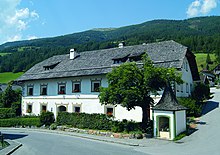Heihsgut
The Heihsgut is one of the oldest still inhabited houses in the Salzburg-Styrian Alps . The residence stands at the foot of the Speiereck ( Radstädter Tauern ) in the center of Sankt Martin . Together with a small chapel and a toe box , it becomes the secular counterpart for the village church , on whose cemetery a Mithras shrine was found in the 19th century under the Karner .
history
In 1478 the eponymous family bought the house as Ir frey Aigens guet from the Styrian Benedictine Abbey of St. Lambrecht . It probably belonged to the estate at St. Mörten that was devastated in a dispute between the Bishop of Bamberg , the monastery and the Counts of Ortenburg, and which Rudolf von Habsburg finally granted the monks in 1278.
At the church, three tombstones represent the rise and fall of the family associated with the prosperity and poverty of the Gau: a large, but simple stone for the purchaser of the house, a rather splendid one with that of Charles V in 1532 . lent coat of arms for his son Lienhard and a small plaque for the last owner, the grandson of Charles VI's grandson, who died in poverty in 1839 in 1730 . ennobled Andreas v. Heihs.
The family's rank in the 16th century is evidenced by the pine parlor from 1545, a waffle iron with the Heihswappen from 1559 and a large tombstone with a portrait and coat of arms for the brother of Lienhard, who died in 1544 as pastor of St. Michael and Murau and archdeacon of Lungau in the parish church.
His niece Apollonia, a daughter of Lienhard, and her husband, Hanns Gennsprunner zu Radstadt, enlarged the house using a bricked grain box and built the large stone pine room on the first floor. That was according to an inscription above the door frame in 1545. Perhaps it was only the construction of the large toe box marked 1685 that made it possible to incorporate the old box into the structure of the house. The house remained in the possession of the Heiss family until 1838. It is currently owned by the Plöchl family.
Current condition
A fire in 1925 severely damaged the house, and when it was rebuilt it was structurally altered. The rustic painting of the facade was renewed after its exposure in 1975.
Together with a vaulted cellar and a room above it with a coffered ceiling , a closed structure was created, with the main entrance moving out of the center of the facade. In this cassette room is now the family archive, which also contains material about the canon lawyer Willibald M. Plöchl, who died in 1984, and his efforts to establish a government in exile in the USA.
The Zirbenstube, renovated in 1999 with the support of the State of Salzburg, is also open to the public. During the restoration, the location of the secret spiral staircase that Ignaz von Kürsinger described in 1853 but never saw was clarified .
A small collection documents the place of the house and the family in the village history; she shows u. a. some old chests, the waffle iron from 1559 and a few works by one of the most famous artists of the Wiener Werkstätten , Dagobert Peche (1887–1923), born in St. Michael .
The Heihsgut is a listed building .
The floor of the old Rauchkuchl was equipped with hand-cut bricks from the Falkinger brickworks in Grafenstein .
literature
- Georg Clam Martinic : Castles and palaces in Austria. Landesverlag in Veritas Verlag, Linz 1991, ISBN 3-85214-559-7 .
- Ignaz von Kürsinger : Lungau. Historically, ethnographically and statistically from previously unused documentary sources presented Oberersche Buchhandlung 1853 ( Webrepro, Google in the Google book search; reprint: Österreichischer Kunst- und Kulturverlag, St. Johann im Pongau 1981, ISBN 978-3-85437-002-4 )
- Friederike Zaisberger , Walter Schlegel : Castles and palaces in Salzburg - Pongau, Pinzgau, Lungau , Birken-Verlag Vienna, 1978, ISBN 3-85030-037-4
- Dehio manual. The art monuments of Austria. Salzburg . 1986 ISBN 3-7031-0599-2 , keyword: St. Martin im Lungau, house no.1, Heihshaus
Individual evidence
- ↑ Georg Clam Martinic, 1991, p. 277.
Web links
Coordinates: 47 ° 5 '59.6 " N , 13 ° 39' 14.1" E
